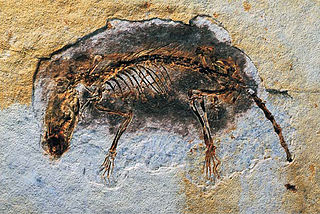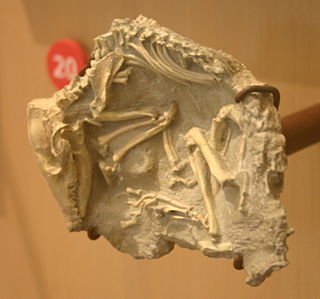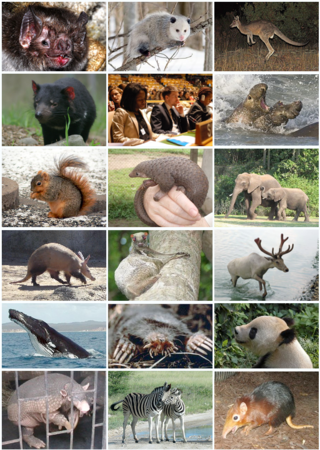
Marsupials are any members of the mammalian infraclass Marsupialia. All extant marsupials are endemic to Australasia, Wallacea and the Americas. A distinctive characteristic common to most of these species is that the young are carried in a pouch. Living marsupials include opossums, Tasmanian devils, kangaroos, koalas, wombats, wallabies, and bandicoots among others, while many extinct species, such as the thylacine, are also known.

Multituberculata is an extinct order of rodent-like mammals with a fossil record spanning over 130 million years. They first appeared in the Middle Jurassic, and reached a peak diversity during the Late Cretaceous and Paleocene. They eventually declined from the mid Paleocene onwards, disappearing from the known fossil record in the late Eocene. They are the most diverse order of Mesozoic mammals with more than 200 species known, ranging from mouse-sized to beaver-sized. These species occupied a diversity of ecological niches, ranging from burrow-dwelling to squirrel-like arborealism to jerboa-like hoppers. Multituberculates are usually placed as crown mammals outside either of the two main groups of living mammals—Theria, including placentals and marsupials, and Monotremata—but usually as closer to Theria than to monotremes. They are considered to be closely related to Euharamiyida and Gondwanatheria as part of Allotheria.

Placental mammals are one of the three extant subdivisions of the class Mammalia, the other two being Monotremata and Marsupialia. Placentalia contains the vast majority of extant mammals, which are partly distinguished from monotremes and marsupials in that the fetus is carried in the uterus of its mother to a relatively late stage of development. The name is something of a misnomer considering that marsupials also nourish their fetuses via a placenta, though for a relatively briefer period, giving birth to less developed young which are then nurtured for a period inside the mother's pouch.

Eomaia is a genus of extinct fossil mammals containing the single species Eomaia scansoria, discovered in rocks that were found in the Yixian Formation, Liaoning Province, China, and dated to the Barremian Age of the Lower Cretaceous about 125 million years ago. The single fossil specimen of this species is 10 centimetres (3.9 in) in length and virtually complete. An estimate of the body weight is between 20–25 grams (0.71–0.88 oz). It is exceptionally well-preserved for a 125-million-year-old specimen. Although the fossil's skull is squashed flat, its teeth, tiny foot bones, cartilages and even its fur are visible.

Eutheria is the clade consisting of all therian mammals that are more closely related to placentals than to marsupials.

Metatheria is a mammalian clade that includes all mammals more closely related to marsupials than to placentals. First proposed by Thomas Henry Huxley in 1880, it is a more inclusive group than the marsupials; it contains all marsupials as well as many extinct non-marsupial relatives.

Theria is a subclass of mammals amongst the Theriiformes. Theria includes the eutherians and the metatherians but excludes the egg-laying monotremes and various extinct mammals evolving prior to the common ancestor of placentals and marsupials.
The Late Cretaceous is the younger of two epochs into which the Cretaceous Period is divided in the geologic time scale. Rock strata from this epoch form the Upper Cretaceous Series. The Cretaceous is named after creta, the Latin word for the white limestone known as chalk. The chalk of northern France and the white cliffs of south-eastern England date from the Cretaceous Period.

Sinodelphys is an extinct eutherian from the Early Cretaceous, estimated to be 125 million years old. It was discovered and described in 2003 in rocks of the Yixian Formation in Liaoning Province, China, by a team of scientists including Zhe-Xi Luo and John Wible.

Protungulatum is a extinct genus of pan-euungulate mammals within extinct family Protungulatidae, and also one of the earliest known placental mammals in the fossil record, that lived in North America from the Late Cretaceous to early Paleocene.

Cimolestes is a genus of early eutherians with a full complement of teeth adapted for eating insects and other small animals. Paleontologists have disagreed on its relationship to other mammals, in part because quite different animals were assigned to the genus, making Cimolestes a grade taxon of animals with similar features rather than a genus of closely related ones. Fossils have been found in North America, South America, Europe and Africa. Cimolestes first appeared during the Late Cretaceous of North America. According to some paleontologists, Cimolestes died out at the start of the Paleocene, while others report the genus from the early Eocene.

The evolution of mammals has passed through many stages since the first appearance of their synapsid ancestors in the Pennsylvanian sub-period of the late Carboniferous period. By the mid-Triassic, there were many synapsid species that looked like mammals. The lineage leading to today's mammals split up in the Jurassic; synapsids from this period include Dryolestes, more closely related to extant placentals and marsupials than to monotremes, as well as Ambondro, more closely related to monotremes. Later on, the eutherian and metatherian lineages separated; the metatherians are the animals more closely related to the marsupials, while the eutherians are those more closely related to the placentals. Since Juramaia, the earliest known eutherian, lived 160 million years ago in the Jurassic, this divergence must have occurred in the same period.

Dryolestida is an extinct order of mammals, known from the Jurassic and Cretaceous. They are considered members of the clade Cladotheria, close to the ancestry of therian mammals. It is also believed that they developed a fully mammalian jaw and also had the three middle ear bones. Most members of the group, as with most Mesozoic mammals, are only known from fragmentary tooth and jaw remains.

Ocepeia is an extinct genus of afrotherian mammal that lived in present-day Morocco during the middle Paleocene epoch, approximately 60 million years ago. First named and described in 2001, the type species is O. daouiensis from the Selandian stage of Morocco's Ouled Abdoun Basin. A second, larger species, O. grandis, is known from the Thanetian, a slightly younger stage in the same area. In life, the two species are estimated to have weighed about 3.5 kg (7.7 lb) and 10 kg (22 lb), respectively, and are believed to have been specialized leaf-eaters. The fossil skulls of Ocepeia are the oldest known afrotherian skulls, and the best-known of any Paleocene mammal in Africa.

Pappotherium is an extinct genus of mammals from the Albian of Texas, US, known from a fossilized maxilla fragment bearing two tribosphenic molars, discovered within the Glen Rose Formation near Decatur, Wise County, Texas.
Ukhaatherium is a now extinct species of mammal that lived during the upper Cretaceous about 84 to 72 million years ago in today's East Asia. It is known above all from the fossil locality Ukhaa Tolgod, Mongolia. An adult Ukhaatherium has an estimated weight of about 32g and bears several similarities to lipotyphlan insectivorans such as the tenrec.
Altacreodus is an extinct genus of eutherian mammals. Fossils have been found in North America where they first appeared during the Late Cretaceous, and they died out prior to the start of the Paleocene.

Durlstodon is a genus of extinct mammal from the Early Cretaceous of Southern England. It contains a single species, Durlstodon ensomi, which is known from molars found in the Berriasian Lulworth Formation of Durlston Bay, Dorset, after which the genus was named. The species name honours Paul Ensom, discoverer of many fossil mammals from Lulworth. Durlstodon and two of its contemporaries, Tribactonodon and Durlstotherium, had tribosphenidan (three-cusped) molars, which are an advanced characteristic among eutherian mammals and suggest that the group emerged earlier than the Early Cretaceous.

Gypsonictops is an extinct genus of leptictidan mammals of the monotypic family Gypsonictopidae, which was described in 1927 by George Gaylord Simpson. Species in this genus were small mammals and the first representatives of the order Leptictida, that appeared during the Upper Cretaceous.
Ambolestes is an extinct genus of eutherian mammal from the Early Cretaceous of China. It includes a single species, Ambolestes zhoui, known from a single complete skeleton recovered from the Yixian Formation, part of the fossiliferous Jehol biota. Ambolestes is one of the most basal eutherians, presenting a combination of features from both early eutherians (stem-placentals) and early metatherians (stem-marsupials). This is responsible for the generic name of Ambolestes: "ambo" is Latin for "both", while "-lestes" is a popular suffix for fossil mammals. The species name honors influential Jehol paleontologist Zhou Zhonghe.




















